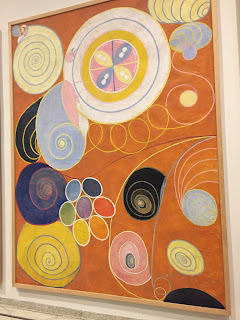My experience at the Guggenheim museum wouldn’t have been the same if I didn't do research on the history of both, Theosophy and Hilma beforehand because I walked in pretty aware that Hilma’s art took on certain abstract shapes, colors, figures, and letters that potentially expresses the spirit of our world. It was interesting to learn of how she was able to use her deep involvement in spiritualism in which Theosophy was included as the source to her motivation to create something that wasn’t being made in the time period she existed in.
I found it interesting to know that at the turn of the 20th century the world was on the brink of change and iconic artists like Vasily Kandinsky and Piet Mondrian began to change the ways they expressed art and began to perceive reality with signs while combining natural color and symbolic color to create a revolutionary form of abstraction. I couldn’t say the same for Hilma though. She doesn’t belong in the same conversation since her abstract work predates these artist that we have long considered pioneers of abstraction. It was very unfortunate to hear that Hilma’s work went unknown for so long but I feel like I understand why she insisted her work be shown 20 years after she died. I believe the reason is because contemporary criticism wouldn’t of been fond of an uncommon form of art that possibly jeopardizes a specific way of thinking and believing in the 1900’s. It is clear that her relationship with spiritualism catapulted her mindset where she was able to convey a completely different way of expression.
Hilma helps me believe that there isn’t just one way to express beliefs, feelings, ideas, and so on. In my opinion this is a great example of why I know there should never be a limit on what one can believe in. There are many ways to think and believe. From it, there can be incredible results, some even life changing, although, I’m also aware that there can be critical backlash from it. The 1900’s were not prepared for art that both displayed odd abstract form and highly advanced perception that clearly would challenge 20th century belief. Hilma’s art suggests something more than what meets the eye. She was too busy avoiding the surface which led her to utilize spiritualism and science to spark her interests in new ideas, which allowed her to become a potent vehicle of translation, transporting extensive amounts of information by using transcendent spiritual guides that she in return reveals as a different way of defining the world.
From what I’ve read and watched, Klint wasn’t afraid to be different and she also acknowledged the world for what it was at that time and knew she couldn’t display her work in a time where the public would only view her as cuckoo. I feel that life in the 21st century is capable of accepting her unique work of art as opposed to the life in the 20th century because political scientific and cultural evolution is constantly changing, therefore an art form like hers could be better appreciated due to a higher understanding of modern beliefs.
In my eyes she is an innovator, someone that desired more than what was offered in front of her. I say this because I can truly relate to her. Much like her, I am constantly searching for more. I am not satisfied with what is available so I seek for the things that are unavailable. In her case, she uses spiritualism to propel her work on to a different level of how it should be interpreted by humanity. She influences you to actually want to learn how to translate her work, and that’s what makes it brilliant. It’s something we’ve never seen before and it has left the world “with so many questions and not enough answers” which makes her art completely unidentifiable yet that much more intriguing. It’s so different that at first its discouraging because it’s absolutely foreign to the mind. But, if you’re the type of person that enjoys deciphering things for your own personal gratification like the way I do then you’ll be motivated to find meaning in anything, no matter what it is.
In Deepak Chopra’s excerpt from “You Are the Universe,” he states, we are left with two options. Either “What came before the big bang?” is an impossible question to answer, or else extraordinary means must be discovered that could possibly reveal an answer. I read this and automatically thought of Hilma. She didn’t sit around waiting for others to get answers for her, she attained it herself, and spiritualism eventually helped Klint make the major artistic breakthrough represented by the “Paintings for the Temple.” Interestingly, employing spiritualism as a way to break from the constraints of the past gained attention from other women. Actually, the majority of spiritual mediums during that period were women, and many used channelings as a way to overcome society’s marginalization of their voices by claiming direct access to an absolute authority.





No comments:
Post a Comment